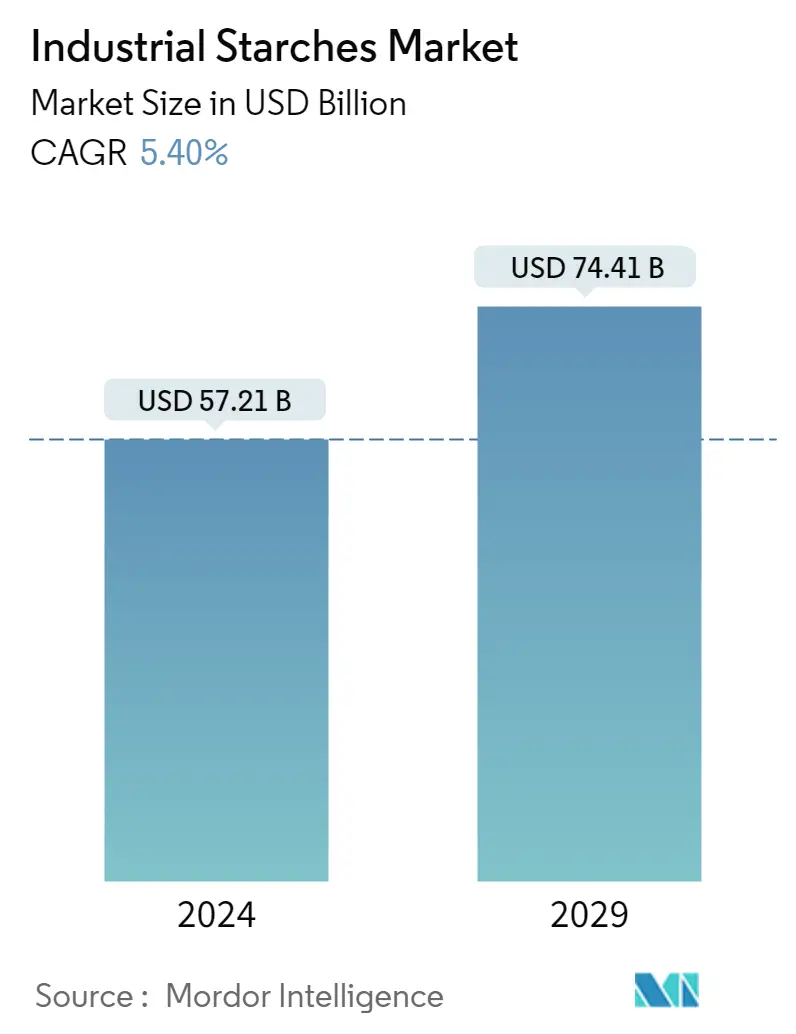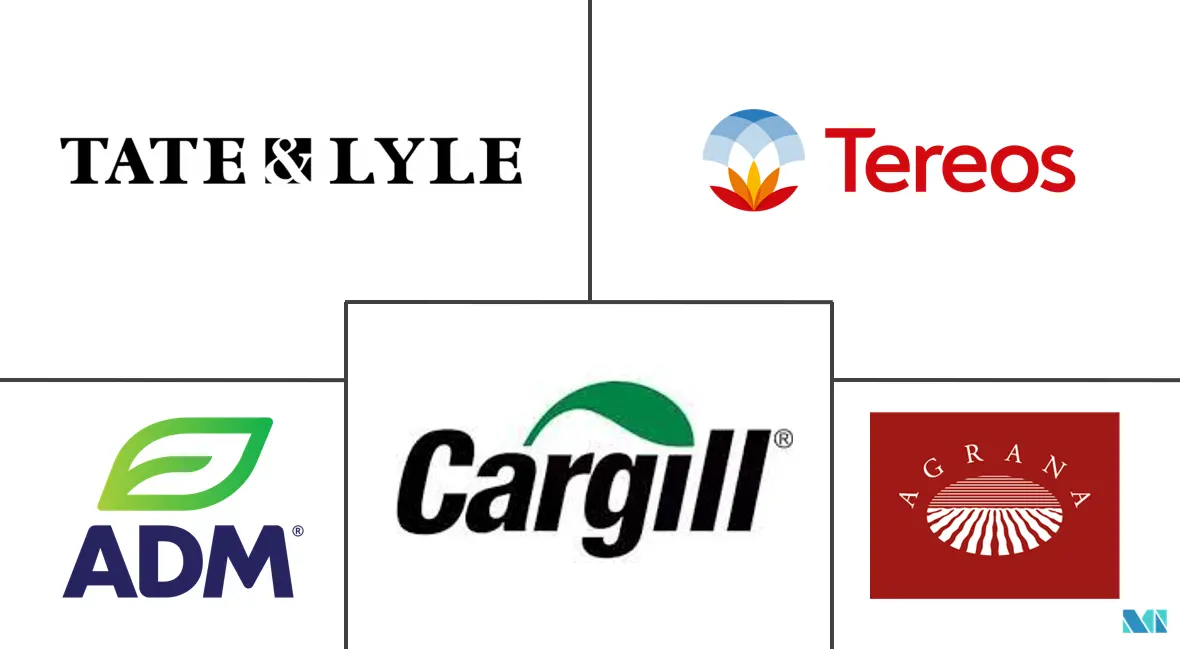Market Size of Industrial Starches Industry

| Study Period | 2019 - 2029 |
| Market Size (2024) | USD 57.21 Billion |
| Market Size (2029) | USD 74.41 Billion |
| CAGR (2024 - 2029) | 5.40 % |
| Fastest Growing Market | Asia-Pacific |
| Largest Market | North America |
| Market Concentration | Low |
Major Players
*Disclaimer: Major Players sorted in no particular order |
Industrial Starch Market Analysis
The Industrial Starches Market size is estimated at USD 57.21 billion in 2024, and is expected to reach USD 74.41 billion by 2029, growing at a CAGR of 5.40% during the forecast period (2024-2029).
Starch is a carbohydrate extracted from agricultural raw materials, which finds applications in many everyday food and non-food products. Industrial starches are derived from various sources, including corn, potato, wheat, and other sources. With the global economy gradually improving and resulting in an increased intake of processed and convenience foods, the market for industrial starch, which finds substantial usage in these food applications, is finding increased demand, thereby driving the overall market.
The demand for modified starches is increasing in parallel with the rapid development of the food industry. Modified starches offer many functional benefits to various foods, such as bakeries, snacks, beverages, and nutritional foods. Currently, a wide range of starches are available in the market, studied in the form of native starches, modified starches, malt dextrin, starch-based sugars, and others. These starches have expanding applications, primarily in the beverage and confectionery industries and the pharmaceutical and fermentation industries, among others, driving the market.
Industrial Starch Industry Segmentation
Industrial starch is derived from various natural sources such as wheat, corn, cassava, potato, and other sources. Industrial starch is extensively used in the paper industry during the manufacturing and coating process. The global industrial starch market is segmented by type into native and starch derivatives and sweeteners. Based on source, the market is segmented into corn, wheat, cassava, potato, and other sources. The market is segmented by application into food and beverage, feed, paper, pharmaceutical, and other applications. Also, the report provides global insights into the industrial starches market in the major economies across regions, including North America, Europe, Asia-Pacific, South America, Middle East and Africa. For each segment, the market sizing and forecasting have been done in value terms of USD million.
| By Type | |
| Native | |
| Starch Derivatives & Sweeteners |
| By Source | |
| Corn | |
| Wheat | |
| Cassava | |
| Potato | |
| Other Sources |
| By Application | |
| Food | |
| Feed | |
| Paper Industry | |
| Pharmaceutical Industry | |
| Other Applications |
| By Geography | |||||||||
| |||||||||
| |||||||||
| |||||||||
| |||||||||
|
Industrial Starches Market Size Summary
The industrial starch market is poised for significant growth, driven by its extensive applications across various industries. Starch, a carbohydrate derived from agricultural raw materials, is increasingly utilized in both food and non-food products. The market is experiencing heightened demand due to the global economic recovery and the rising consumption of processed and convenience foods. Modified starches, in particular, are gaining traction within the food industry for their functional benefits in products such as baked goods, snacks, and beverages. The versatility of starches, including native and modified varieties, malt dextrin, and starch-based sugars, is expanding their use in sectors like beverages, confectionery, pharmaceuticals, and fermentation. Corn starch, known for its textural properties, is especially sought after in the dairy and beverage industries and is pivotal in developing gluten-free products, a growing trend influenced by clean-label demands.
Regionally, North America leads the industrial starch market, with the United States being a major corn producer, supporting the starch production industry. The market's focus on gluten-free products is bolstered by stringent U.S. regulations on gluten-free labeling, favoring corn and potato-derived starches over wheat-based ones. The Canadian market is also expanding, driven by consumer preferences for healthier, cleaner ingredients. The industrial starch market is highly competitive, with numerous local, regional, and international players like Archer Daniels Midland Company, Cargill Incorporated, Tate & Lyle PLC, and The Tereos Group. These companies are actively pursuing expansion, product innovation, and strategic partnerships to enhance their market presence. Recent developments include Ingredion's launch of sustainable barrier starches in North America and Cargill's expansion of specialty tapioca starch offerings in the Asia-Pacific region, highlighting the industry's dynamic nature and ongoing evolution.
Industrial Starches Market Size - Table of Contents
-
1. MARKET DYNAMICS
-
1.1 Market Drivers
-
1.2 Market Restraints
-
1.3 Porter's Five Forces Analysis
-
1.3.1 Threat of New Entrants
-
1.3.2 Bargaining Power of Buyers/Consumers
-
1.3.3 Bargaining Power of Suppliers
-
1.3.4 Threat of Substitute Products
-
1.3.5 Intensity of Competitive Rivalry
-
-
-
2. MARKET SEGMENTATION
-
2.1 By Type
-
2.1.1 Native
-
2.1.2 Starch Derivatives & Sweeteners
-
-
2.2 By Source
-
2.2.1 Corn
-
2.2.2 Wheat
-
2.2.3 Cassava
-
2.2.4 Potato
-
2.2.5 Other Sources
-
-
2.3 By Application
-
2.3.1 Food
-
2.3.2 Feed
-
2.3.3 Paper Industry
-
2.3.4 Pharmaceutical Industry
-
2.3.5 Other Applications
-
-
2.4 By Geography
-
2.4.1 North America
-
2.4.1.1 United States
-
2.4.1.2 Canada
-
2.4.1.3 Mexico
-
2.4.1.4 Rest of North America
-
-
2.4.2 Europe
-
2.4.2.1 Spain
-
2.4.2.2 United Kingdom
-
2.4.2.3 Germany
-
2.4.2.4 Russia
-
2.4.2.5 France
-
2.4.2.6 Italy
-
2.4.2.7 Rest of Europe
-
-
2.4.3 Asia-Pacific
-
2.4.3.1 China
-
2.4.3.2 Japan
-
2.4.3.3 India
-
2.4.3.4 Australia
-
2.4.3.5 Rest of Asia-Pacific
-
-
2.4.4 South America
-
2.4.4.1 Brazil
-
2.4.4.2 Argentina
-
2.4.4.3 Rest of South America
-
-
2.4.5 Middle East and Africa
-
2.4.5.1 South Africa
-
2.4.5.2 United Arab Emirates
-
2.4.5.3 Rest of Middle East and Africa
-
-
-
Industrial Starches Market Size FAQs
How big is the Industrial Starches Market?
The Industrial Starches Market size is expected to reach USD 60.30 billion in 2025 and grow at a CAGR of 5.40% to reach USD 78.44 billion by 2030.
What is the current Industrial Starches Market size?
In 2025, the Industrial Starches Market size is expected to reach USD 60.30 billion.

